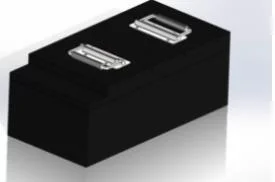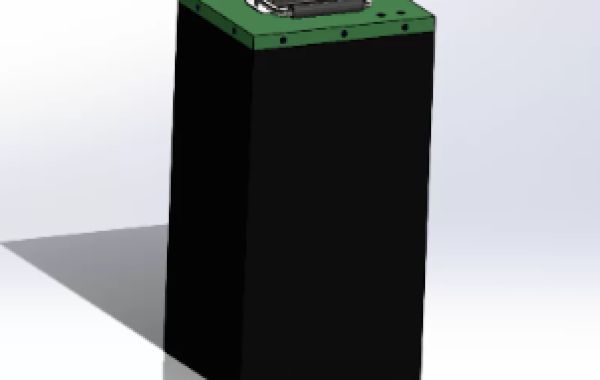Lithium battery is the representative of modern high-performance battery, which consists of four main parts: positive electrode material, negative electrode material, separator, and electrolyte. Among them, the separator is a thin film with a microporous structure, which is a key inner layer component with more technical barriers in the lithium battery industry chain. It plays the following two main roles in lithium batteries: a. Separating the positive and The negative electrode prevents the positive and negative electrodes from contacting to form a short circuit; b. The micropores in the film can allow lithium ions to pass through, forming a charge-discharge circuit. Next, the lithium battery supplier Winshinepower will introduce the production process of lithium battery separators in detail.
1. Cost composition of lithium batteries
High-performance lithium batteries require separators with uniform thickness and excellent mechanical properties (including tensile strength and puncture resistance), gas permeability, and physical and chemical properties (including wettability, chemical stability, thermal stability, and safety). It is understood that the quality of the separator directly affects the capacity, cycle capacity, and safety performance of lithium batteries, and the separator with excellent performance plays an important role in improving the overall performance of the battery.
The many characteristics of lithium battery separators and the difficulty of taking into account their performance indicators determine the high technical barriers to their production processes and the difficulty of research and development. The production process of lithium battery separator includes raw material formulation and rapid formulation adjustment, micropore preparation technology, independent design of complete sets of equipment, and many other processes.
Among them, the micropore preparation technology is the core diaphragm of the lithium battery diaphragm preparation process. According to the difference of the micropore formation mechanism, the diaphragm process can be divided into two types: the dry method and the wet method.
2. Lithium battery separator process
2.1.1 Lithium battery dry separator process
Dry-process separators are divided into single-stretching and double-stretching according to the stretching orientation. The lithium battery dry-process membrane process is the most commonly used method in the preparation process of the membrane. The process is to mix raw materials such as high molecular polymers and additives to form a uniform melt. During extrusion, a lamellar structure is formed under tensile stress, and a hard and elastic polymer film is obtained by heat treatment of the lamellar structure, and then stretched at a certain temperature to form slit-shaped micropores, and a microporous film is obtained after heat-setting.
At present, the dry process of lithium batteries mainly includes two processes: dry uniaxial stretching and biaxial stretching. Dry single drawing uses polyethylene (PE) or polypropylene (PP) polymers with good fluidity and low molecular weight and uses the manufacturing principle of hard elastic fibers to first prepare high-orientation, low-crystalline polymers. After the olefin cast sheet is stretched at low temperature to form micro-defects such as silver streaks, high-temperature annealing is used to open the defects, thereby obtaining a microporous film with uniform pore size and uniaxial orientation.
2.1.2 The dry single drawing process of lithium battery is as follows:
1) Feeding: raw materials such as PE or PP and additives are pretreated according to the formula, and then transported to the extrusion system.
2) Casting: the pretreated raw materials are melted and plasticized in the extrusion system, and then extruded from the die head to melt the membrane, and the melt is cast to form a base film with a specific crystal structure.
3) Heat treatment: After heat treatment of the base film, a hard elastic film is obtained.
4) Stretching: The hard elastic film is cold-stretched and hot-stretched to form a nano-microporous membrane.
5) Slitting: Cut the nano-microporous membrane into finished membranes according to the customer's specifications.
The lithium battery dry double-drawing process is a process with independent intellectual property rights developed by the Institute of Chemistry, Chinese Academy of Sciences, and it is also a unique manufacturing process for diaphragms in my country.
Because the β crystal form of PP is hexagonal, the single crystal nucleates, and the wafers are loosely arranged. It has a lamellar structure that grows radially into a divergent bundle and does not have a complete spherulite structure. Under the action of heat and stress, It will transform into a more dense and stable alpha crystal, which will create holes inside the material after absorbing a lot of impact energy.
In this process, a β-crystal modifier with nucleation is added to PP, and the difference in density between different phases of PP is used to form micropores during the stretching process.

2.1.3 The lithium battery dry double-drawing process is as follows:
1) Feeding: The raw materials such as PP and pore former is pretreated according to the formula and sent to the extrusion system.
2) Casting: PP cast sheets with high β-crystal content and good β-crystal morphology uniformity are obtained.
3) Longitudinal stretching: longitudinally stretching the cast sheet at a certain temperature, and using the characteristics of β crystals that are easy to form pores under tensile stress to form pores.
4) Lateral stretching: The samples were laterally stretched at a higher temperature to expand the pores and at the same time improve the uniformity of the pore size distribution.
5) Forming and winding: By heat-treating the diaphragm at high temperatures, the thermal shrinkage rate is reduced and the dimensional stability is improved.
2.2.1 Lithium battery wet process
The lithium battery wet separator is divided into asynchronous and synchronous according to whether the stretching orientation is at the same time. The lithium battery wet process uses the principle of thermally induced phase separation to separate plasticizers (high-boiling hydrocarbon liquids or some substances with relatively low molecular weights). ) is mixed with polyolefin resin, and the phenomenon of solid-liquid phase or liquid-liquid phase separation occurs during the cooling process of the molten mixture, and the film is pressed, heated to a temperature close to the melting point, and then stretched to make the molecular chain orientation consistent. Volatile solvents, such as dichloromethane and trichloroethylene, extract the plasticizer from the film, resulting in an interconnected submicron-sized microporous membrane material.
The wet process is suitable for the production of thinner single-layer PE separators for lithium batteries. According to whether the orientation is simultaneous during stretching, the wet process can also be divided into two types: the lithium battery wet process wet bidirectional asynchronous stretching process and the lithium battery wet process bidirectional synchronous stretching process.
2.2.2 The process flow of wet asynchronous stretching is:
1) Feeding: The raw materials such as PE and pore former are pretreated and transported to the extrusion system according to the formula.
2) Casting: The pretreated raw materials are melted and plasticized in a twin-screw extrusion system, and then extruded from the die head.
3) Longitudinal stretching: the cast slab is longitudinally stretched.
4) Transverse stretching: the cast slab after longitudinal stretching is transversely stretched to obtain a base film containing a pore-forming agent.
5) Extraction: The base film is solvent-extracted to form a base film without a pore-forming agent.
6) Shape: the base film without a pore-forming agent is dried and shaped to obtain a nano-microporous film.
7) Slitting: Cut the nano-microporous membrane into finished membranes according to the customer's specifications.
Wet asynchronous stretching process The wet synchronous stretching technology process is basically the same as the asynchronous stretching technology, except that it can be oriented in the horizontal and vertical directions at the same time during stretching, eliminating the need for a separate longitudinal stretching process and enhancing the lithium-ion Battery separator thickness uniformity. However, the problem with synchronous stretching of lithium batteries is that the speed of the vehicle is slow, and the second is that the adjustability is slightly poor. Only the horizontal stretching ratio is adjustable, and the longitudinal stretching ratio is fixed.
The wet coating is the development direction of the lithium battery separator
The overall performance of the wet diaphragm is better than that of the dry diaphragm. The matrix material and the manufacturing process affect the diaphragm product's performance. The stability, consistency, and safety of the separator have a decisive impact on the discharge rate, energy density, cycle life, and safety of lithium batteries. Compared with the dry diaphragm, the wet diaphragm has better material properties such as thickness uniformity, mechanical properties (tensile strength, puncture resistance), air permeability, and physical and chemical properties (wetting, chemical stability, safety). In order to be excellent, it is beneficial to the liquid absorption and liquid retention of lithium battery electrolytes and improves the battery's charge-discharge and cycle capacity, and is suitable for high-capacity batteries. From the perspective of product strength, the comprehensive performance of the lithium battery wet separator is stronger than that of the dry separator.
Well, the above is the whole content of the lithium battery separator technology brought to you by the lithium battery seller Winshinepower. I hope the above content will be helpful to you. For more information on lithium batteries, please refer to our previous articles:
Understanding Impedance Spectroscopy (EIS) of Li-ion Batteries








